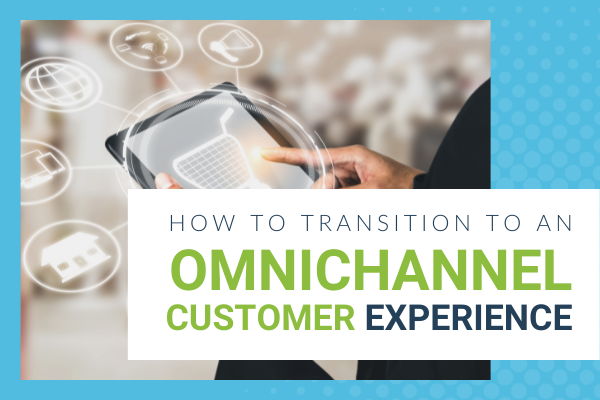Nowadays, your customers have greater expectations than ever before. Not only are they more likely to interact with your business, but they want to interact with your business on their terms. Whether this is through social media, your website, a physical storefront, or phone, these touchpoints are an opportunity to transition to an omnichannel customer experience.
When your experience is seamless across the full customer journey, you keep your customers engaged and enthusiastic about your brand. In fact, companies that invest in omnichannel engagement strategies retain an average of 89% of their customers. When you compare this to the 33% retention for companies with a weak omnichannel strategy, this is nothing to overlook.
While it’s clear you should make transitioning to an omnichannel customer experience a priority, this is easier said than done. You likely already have an existing customer experience journey. Do you really need to scrap that and start from scratch? You’re already stretched to the limit as it is.
Luckily, there’s no need to completely overhaul what’s already working for you. The right omnichannel customer experience fits with your existing brand strategy. It optimizes your processes so you can work smarter not harder. Better yet, you’re more likely to turn passive customers into raving superfans. In this guide, we’ll explore how to transition to an omnichannel customer experience with ease.
What is an omnichannel customer experience?
First, what exactly is an omnichannel customer experience? The word “omnichannel” can be quite the mouthful, but don’t let the definition get away from you. Odds are you’ve already experienced this type of experience for yourself, but it felt so natural you didn’t even notice it.
In short, an omnichannel experience is made up of multiple customer touchpoints over a variety of channels. They all seamlessly connect, making it possible for a customer to pick up exactly where they left on one channel on another. For example, a customer might be shopping online using their phone. From there, they navigate to your social media page to contact a member of your support team. This process should be just as seamless on both platforms.
You already know you need a compelling social media presence, website, and in-person experience. However, if they don’t all work seamlessly together, this isn’t an engaging, enticing experience for customers. An omnichannel customer experience is about making sure all devices and platforms work together perfectly.
According to Google, 90% of users who own multiple devices switch between them every day. They even use an average of devices to complete a single task. Surely you can recognize this in your own life, so why should it be any different for your customers? (Hint: it’s not!) If you’re only effectively engaging with customers on one of their many devices and platforms, you might be losing them altogether.
What are the benefits of creating an omnichannel customer experience?
Now that you understand what an omnichannel customer experience is, how does it translate to the real world? While you always want to improve your touchpoints with customers, why is this particular method so powerful? We can break it down into three main benefits.
Personalized experience
To begin, personalization has never been more important. When customers feel in control of their experience with your brand, they’re happier. Not only do they want the option to talk to your team from multiple devices (ie. social media, email, phone), but they also are empowered to make a purchase on their own terms. When it comes to reducing churn, you want to focus on the individual needs of the customer.
Reach a wider audience
Next, an omnichannel customer experience also helps you build your reach. In other words, you’re meeting customers where they are. They don’t have to come to you to engage with your brand. Your products, services, and team are only a click, message, storefront, or call away. This translates to increased profits. The easier you make it for customers to purchase or sign up, the more likely they’ll actually do it. It’s all about reducing tension when selling.
Earn customer loyalty
Finally, an omnichannel experience creates a one-way path to superfans. Customer loyalty is worth everything nowadays. Your customers don’t want to feel frustrated with roadblocks throughout the buying process. They expect things to be easy and seamless. When they find a brand that focuses on their needs, they’re more likely to buy from that brand again in the future.
How do omnichannel and multichannel customer experience differ?
As you can see, an omnichannel customer experience really packs a huge punch for today’s businesses. That being said, many businesses get it confused with a similar term: multichannel customer experience. What’s the difference between omnichannel and multichannel when it comes to the customer experience?
- Omnichannel: An omnichannel experience gives the user access to multiple channels that are all connected seamlessly.
- Multichannel: On the other hand, a multichannel experience might use a variety of communication tools, but they’re not necessarily connected.
The key difference lies in synchronization. If a customer can’t move between channels seamlessly, it’s not omnichannel marketing. It’s possible to have an amazing social presence, support team, and website without making them work seamlessly as one. Multichannel focuses on the quality of the channels (ie. creating the perfect social media ad) vs. the quality of the experience. While both are beneficial for engagement, the world is moving rapidly towards omnichannel.
Even though the best approach is typically an omnichannel experience, this doesn’t mean expanding your channels isn’t important. It’s important to communicate with your customers in as many ways as possible, especially if you’re focusing on their needs. Ultimately, it pays to be where your customers are. An omnichannel approach is always a multichannel approach, however, the opposite isn’t true.
How do you create an omnichannel customer experience?
With that in mind, how do you create a successful omnichannel customer experience for your brand? Whether you’re already using a multichannel approach or you’re starting from scratch, it ties into many of the things you already know about marketing and brand engagement.
Step 1. Know your audience
Before you do anything else, you need to know your audience. If you create an omnichannel experience without considering the needs of your customer, you’ll likely end up wasting your time. Research your customers, understand what they want, and know where they are. This might include both online and offline channels.
A great place to start is by building a client profile. When you know what your ideal customer looks like, where he/she spends time, and how they prefer to interact, you’re ready to get started. When in doubt, don’t guess. Ask! Your existing customers are a great resource for learning which channels matter the most.
Step 2. Map your customer stages
Next, begin to map your customer journey stages. These are the steps each customer takes from learning about your brand to making a purchase and beyond. You’ll want to highlight key areas of your customer journey where you can add omnichannel elements. The stages usually follow the general path below:
- Awareness: Your customer learns about your brand through some kind of exposure or interaction.
- Consideration: The customer does basic research, learning more about you and the product/service.
- Decision: They’ve decided it’s time to make a purchase.
- Experience: Their experience with the product/service impacts their feelings.
- Loyalty: Your customer will continue to make repeat purchases or refer you to others.
If you notice, for example, that you lose customers between the experience and loyalty stage, this might be a chance to ask for feedback. Following up with an email or live chat service can reduce tension, making sure customers feel empowered to ask for the help they need.
Step 3. Start with the basic platforms
From there, don’t overwhelm yourself by trying to do everything at once. Yes, you should be on multiple platforms, but this doesn’t mean you have to be on all of them. This spreads your brand too thin. Instead, start with the basics. This includes a website and social media presence. Engage with users on the platforms they’re already spending their time. This might just be 2-3 to start out, and that’s perfectly okay.
You should only invest in platforms that you can reasonably manage long-term. If you can’t keep up with a blog posting schedule or 5+ social media channels, it’s better to scale back. You’re building expectations every step of the way. If you’re known for witty posts on Twitter, make sure you’re consistent on your other platforms. Your users will slowly learn from this consistent brand messaging.
Step 4. Keep your brand story consistent
If you want to build an omnichannel customer experience, you can’t overlook your messaging. Your branding needs to be consistent and memorable on every platform. If you’re running ads across multiple social media channels, for example, your branding and messaging should be consistent.
However, this doesn’t mean you should blindly copy and paste things from one platform to the next. Reusing valuable content is a great idea, but you should always be mindful of how it’s repurposed. Consider changing the content to suit the platform, making sure each post or share comes from a place of consistency and value. When in doubt, make a solid brand voice guide so you know how to share with confidence.
Step 5. Implement support channels across platforms
As we’ve said before, each customer wants to be treated as an individual. They don’t want to feel like another number on a sales page. Just because you prefer to talk with customer support over live chat doesn’t mean everyone feels this way and vice versa. If you implement support channels across platforms, it’s easier to meet customers where they are.
Can your support team easily offer support within your omnichannel system? You want to make it as simple as possible to keep up with customers’ needs, expectations, and past concerns. When this is all in a single place with a consistent CRM system, everyone’s life is easier. We can all understand the frustration of having to explain the situation to multiple agents across platforms. Don’t let your customers fall into the same roadblock.
Step 6. Ask for feedback (and adjust)
Last but not least, making an omnichannel experience is never one-and-done. While this will likely take a bit of time to set up, optimization is an ongoing process. The best way to make sure your channels are working for your customer is to ask them yourself. Additionally, keep an eye on service requests and reviews to make sure you’re meeting expectations.
It’s easy to overlook small things like CTAs that aren’t optimized for the right device or screen resolution issues. It’s okay if it takes a bit of time to work out all the details of your omnichannel experience. As long as you’re willing to learn from your customers and make proactive changes, you’re on the path to success.
Examples of Omnichannel Experiences
Finally, let’s take a look at some real-world examples of omnichannel experiences. By seeing how other companies are implementing these experiences, the easier it is to understand what might work best for your brand.
Disney
First, one of the masters of the omnichannel experience is Disney. From their vacation planning tools on their website to the experience within the theme parks, Disney excels at immersing guests in the Disney magic at every stage of the journey.
It even brings Disney into your home with the My Disney Experience app and Disney+ streaming service. With 70% of first-time visitors returning again, Disney gives endless channels, features, and tools for customers to use to personalize their vacations.
Starbucks
Another omnichannel experience giant is the coffee powerhouse Starbucks. Known for its in-store experience, it launched Starbucks Rewards as a way to leverage the digital experience. Using the app, users can seamlessly order their favorite drinks and foods for pick up right at their local stores.
Similarly, users can pay directly through the app, getting extra loyalty points whether they purchase in-person or online. If there’s one thing to learn from Starbucks’ strategy, it’s that a mobile experience goes a long way.
Crate & Barrel
It’s well known that customers shop between apps and devices before they’re ready to purchase. Crate & Barrel took this to the next level with their omnichannel experience. If a customer logs into their Crate & Barrel account, all their shopping details are saved across devices and through the app.
This means customers never miss a beat, saving their shopping cart for later without any additional steps. Now, they’re taking it a step further with their 3D room design tool. This lets customers use filters to visualize products in their existing space.
How Is Your Omnichannel Strategy?
Ultimately, today’s customers are rarely just one thing. They’re not only online or offline shoppers. They’re not only active on a single social media website or platform. The more integrated your experience, the easier it is to bridge the gap between passive customer and superfan.
Above all, your customers value speed, flexibility, and reliability. They don’t want to worry about their details getting lost in the fray as they switch devices. By optimizing your omnichannel strategy, you show customers that you put them first. Do you need help deciding whether an omnichannel experience is right for your brand? Let’s schedule a chat!





